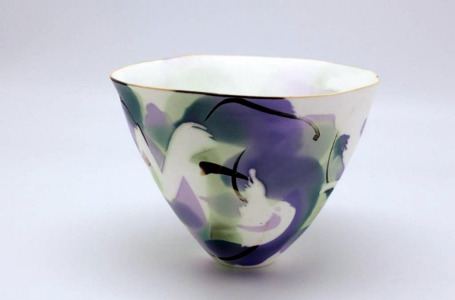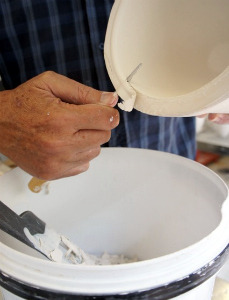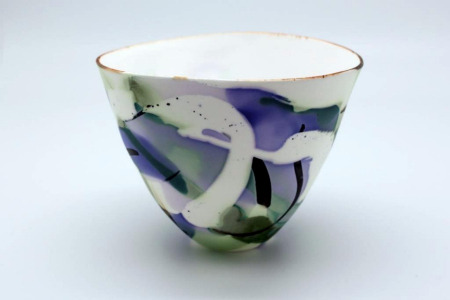
In what technique do you usually work and what materials do you use?
I currently work in a bone china body which I produce from locally available materials. I have always been drawn to translucent bodies, and the one I am currently making is more translucent than any I have used previously. Being bone china it is also whiter than any body I have previously used as the bone ash in the body acts as a bleach on any traces of iron in the body. The work is cast in moulds that I make using Paperplaster. This method uses less plaster than conventional mould making methods and results in much lighter moulds that are far easier to handle. The pieces are bisque fired to 1080oC and then sanded to achieve an extremely smooth surface that I decorate with wax resist and solutions of various soluble salts before the final firing to 1250oC in an electric kiln.
What is the starting point for your investigation with soluble salts?
I have always been intrigued with soluble salts ever since first seeing the work of Arne Åse. A local ceramic supplier had some cobalt chloride that had been on the shelves for some time and presented it to me. So began the tests with solubles, and I am hooked on to this day. I have tested a number of the salts in different solutions and different layers. For some effects, I fire between layers to achieve specific effects. Some of the salts are not available locally, and I work mainly with different strengths of Cobalt, Ferric and Nickel Chloride and Potassium Dichromate solutions.
What did you learn from working with different materials?
I am fascinated by the chemical aspect of the ceramic process, and much of my work has been informed by this. I have previously worked extensively with crystalline glazes and creating reduction effects in electric firings. I think technical challenges are what keep me going, and there is always something to investigate. I find that for me it is essential to focus on one thing at a time and at present I am occupied with the effects of layering the salt solutions.

Releasing bowl trimming the slipcast – View his works
What form of exhibiting do you like most, what suits you? Tell us about your past exhibitions or residencies.
I prefer exhibiting in galleries and have participated in a number of group shows in South Africa. Although I have had solo shows in the past, I have as yet not had a solo show of the soluble work, and it is in my plans though no date is set as yet. I was also fortunate to have one of my pieces selected for exhibit on the 5th World Ceramic Biennale in Korea in 2009 and have also received a merit award for my work at the Ceramics Southern Africa National Exhibition.
Where can we find you and your works in the next future?
Currently, my work is available at a number of South African galleries and craft venues. I am planning a one man show, and it’s in my plans to participate in a group show with two of South Africa’s leading potters. I also plan to enter more international competitions this year.

Wax resist with soluble salt decoration on bone china – View his works
Born in South Africa in 1948, I have been working in ceramics since 1970. Having always been drawn to its translucent and ethereal qualities I worked mainly in porcelain for a number of years. My current work is in Bone China which due to its exceptional translucency seems to be the perfect material for the expression of my ideas. The work is decorated with a combination of wax resist and soluble metallic salts, which permeate the body and create a ‘watercolor’ effect.
Early in 2000 I was employed at the TWR (now University of Johannesburg), and I enrolled for my B Tech Ceramic Design. It was during this period that my experimentation with bone china began, and I produced a body of extreme whiteness with excellent translucency. My early work in bone china was pierced and sandblasted. On completion of my B Tech, for which I gained a distinction in ceramic practice, I started exploring and using soluble salts.
By Vasi Hirdo.
Published in Ceramics Now Magazine Issue 1.
View John Shirley’s profile on Ceramics Now.
Visit John Shirley’s website and his blog.



















